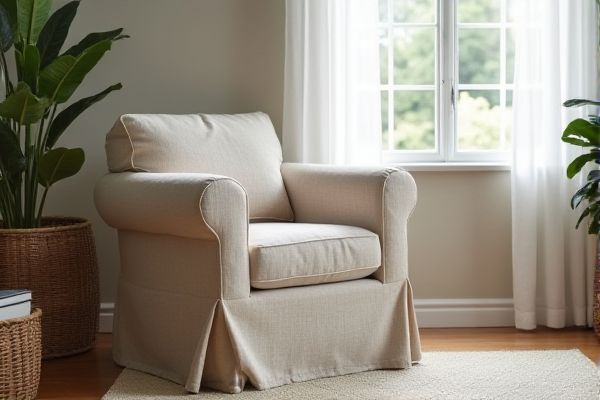
Slipcovers offer a versatile and cost-effective way to protect and refresh your chair's appearance, while upholstered chairs provide a more permanent, tailored look with added comfort. Explore the full article to understand which option best suits your style and lifestyle needs.
Table of Comparison
| Feature | Slipcover Chair | Upholstered Chair |
|---|---|---|
| Definition | Chair with removable fabric cover | Chair with fixed fabric or leather padding |
| Maintenance | Easy to clean and replace | Difficult to clean, requires professional care |
| Customization | High - change styles and colors easily | Low - fixed fabric limits options |
| Durability | Moderate - depends on slipcover quality | High - built for long-term use |
| Cost | Generally lower upfront cost | Generally higher due to materials and craftsmanship |
| Comfort | Varies with slipcover padding and chair structure | Consistent cushioning provides better comfort |
| Style Flexibility | Versatile, easy to update room decor | Less flexible, design fixed at purchase |
| Environmental Impact | Slipcovers reduce waste by extending chair life | Higher impact if replaced frequently |
Introduction: Slipcover vs Upholstered Chair
Slipcover chairs feature removable fabric covers that offer easy customization and cleaning options, making them ideal for changing decor and seasonal updates. Upholstered chairs have fabric, leather, or microfiber materials fixed permanently to the frame, providing a tailored, durable finish that enhances long-term comfort. Choosing between slipcover and upholstered chairs depends on maintenance preferences, style flexibility, and intended usage frequency.
Understanding Slipcovered Chairs
Slipcovered chairs feature removable fabric covers that protect the underlying upholstery while allowing easy customization and cleaning. Unlike upholstered chairs, which have fixed fabric tightly attached to the frame, slipcovers offer flexibility to change styles or refresh your decor without replacing the entire chair. Choosing slipcovered chairs enhances your home's adaptability and simplifies maintenance, making them ideal for busy households or frequent redecorators.
What Are Upholstered Chairs?
Upholstered chairs feature padding, springs, webbing, and fabric or leather covers directly attached to their frame, providing comfort and style. These chairs have a fixed design, with materials tightly fitted and sewn around the structure, offering durability and a sustained aesthetic appeal. Upholstered chairs are often chosen for their ability to blend upholstery craftsmanship with ergonomic support in living rooms, dining areas, or offices.
Key Differences Between Slipcovers and Upholstery
Slipcovers are removable fabric coverings designed to protect or change the look of a chair, offering versatility and ease of cleaning, while upholstery involves permanently attaching fabric to the chair frame for durability and tailored appearance. Slipcovers allow for seasonal or style changes without professional reupholstering costs, whereas upholstered chairs provide enhanced comfort and structural support through padding and fabric choice. The decision between slipcovers and upholstery often depends on maintenance preferences, budget, and long-term aesthetic goals.
Style and Design Versatility
Slipcovers offer exceptional style and design versatility, allowing you to easily change the look of your chair with different fabrics, patterns, and colors to match seasonal trends or personal tastes. Upholstered chairs provide a more permanent and tailored appearance, often featuring intricate details and upscale fabrics that enhance the overall decor with a cohesive, polished look. Your choice depends on whether you prefer the flexibility of updating your chair's style or the durable elegance of fixed upholstery.
Maintenance and Cleaning Comparison
Slipcovers offer the advantage of easy removal and machine washability, making them highly practical for maintaining cleanliness and extending furniture lifespan. Upholstered chairs typically require professional cleaning or spot treatments, which can be more time-consuming and costly over time. Consider the fabric type and usage environment when choosing between slipcovers and upholstery for optimal maintenance efficiency.
Durability and Longevity
Slipcovers offer an extra layer of protection for chairs, making them highly durable by preventing direct wear and tear on the upholstery underneath, which extends the furniture's overall lifespan. Upholstered chairs, while often made with high-quality fabrics and sturdy construction, are more susceptible to stains, fading, and damage over time without additional protective coverings. Choosing slipcovers allows for easy replacement and maintenance, preserving the chair's condition and enhancing longevity compared to solely relying on permanent upholstery.
Cost Considerations
Slipcovers are often a cost-effective option compared to upholstered chairs, as they eliminate the need for expensive fabric and labor-intensive construction. Upholstered chairs typically require professional craftsmanship and high-quality materials, driving up overall expenses. You can save money with slipcovers while still refreshing your furniture's look without the investment of full reupholstery.
Suitability for Different Lifestyles
Slipcovers offer versatility and easy maintenance, making them ideal for busy households with children or pets due to their removable and washable fabric. Upholstered chairs provide a more permanent, tailored look suited for low-traffic areas or formal living spaces where durability and style are prioritized. Choosing between them depends on lifestyle needs, such as high durability and easy cleaning versus elegant design and long-term investment.
Making the Right Choice for Your Home
Choosing between a slipcover and an upholstered chair depends on your lifestyle, aesthetic preferences, and maintenance needs. Slipcovers offer versatility and easy cleaning, ideal for families or frequent redecorators, while upholstered chairs provide durability and a polished look with long-lasting fabric options. Consider your home's traffic, comfort requirements, and style to make the right choice that enhances both function and design.
 homyna.com
homyna.com